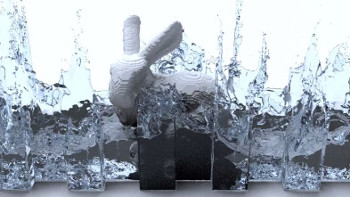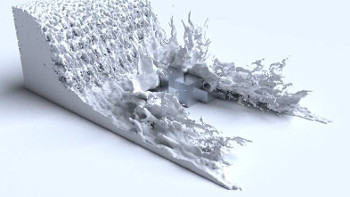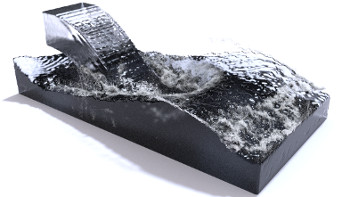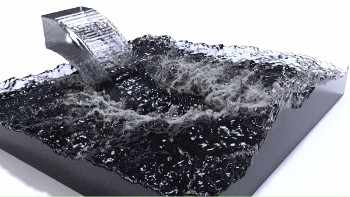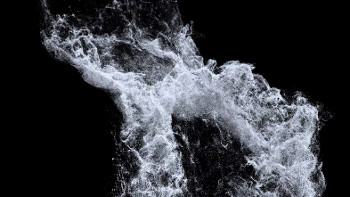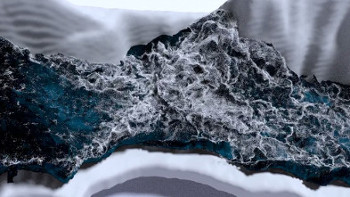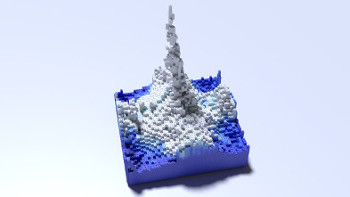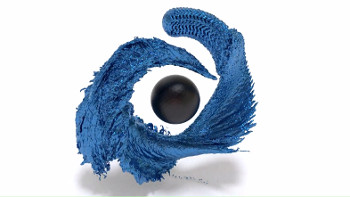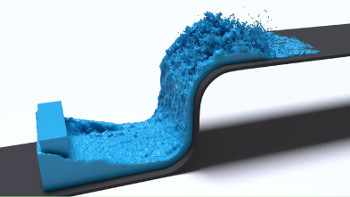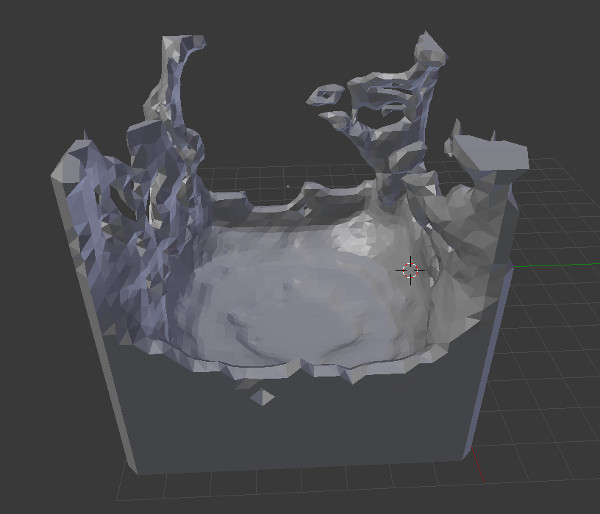This program is an implementation of a PIC/FLIP liquid fluid simulation written in C++11 based on methods described in Robert Bridson's "Fluid Simulation for Computer Graphics" textbook. The fluid simulation program outputs the surface of the fluid as a sequence of triangle meshes stored in the Stanford .PLY file format which can then be imported into your renderer of choice.
The following screencaps are of animations that were simulated within the program and rendered using Blender. Animations created with the fluid simulation program can be viewed on YouTube.
Below is a list of features implemented in the simulator.
- Isotropic and anisotropic particle to mesh conversion
- Spray, bubble, and foam particle simulation
- 'LEGO' brick surface reconstruction
- Save and load state of a simulation
- GPU accelerated fourth-order Runge-Kutta integration using OpenCL
- GPU accelerated velocity advection using OpenCL
There are three dependencies that are required to build this program:
- OpenCL headers (can be found at khronos.org)
- An OpenCL SDK specific to your GPU vender (AMD, NVIDIA, Intel, etc.)
- A compiler that supports C++11
The program can be built with the GNU Make utility. The repository contains two makefiles, Makefile for Windows and Linux, and Makefile-OSX for OS X.
You will need to have the GNU Make utility, OpenCL headers and libraries installed, and a gcc compiler (such as MinGW for Windows).
If OpenCL is not found in your compiler's include/library path, you may edit the Makefile OPENCLINCLUDEPATH and OPENCLLIBPATH variables to point to the directory of your headers and library files (See the comment at the top of the Makefile).
The program can be built and run with the following commands:
make
./fluidsim
You will need to have the GNU Make utility, OpenCL headers and libraries installed, and the clang c++ compiler. These can be obtained by installing Xcode from the Apple App Store.
Depending on your OS X version, the above programs may not be installed automatically. To enable the installation of the command line tools, start Xcode, go to Xcode->Preferences->Downloads and install the component named "Command Line Tools". After that, the required programs should be located in /bin/bash/.
Your OS X machine may not have the required cl.hpp OpenCL C++ wrapper, so you might need to download cl.hpp from khronos.org and place it in:
For Xcode < 4.3
/Developer/SDKs/MacOSX <Version>.sdk/System/Library/Frameworks/OpenCL.framework/Versions/A/Headers
For Xcode >=4.3
/Applications/Xcode.app/Contents/Developer/Platforms/MacOSX.platform/Developer/SDKs/MacOSX <Version>.sdk/System/Library/Frameworks/OpenCL.framework/Versions/A/Headers
You will need the cl.hpp file version that matches the version of OpenCL on your machine. To find out what version of OpenCL you have, locate the cl.h header and look for largest version number listed under the /* OpenCL Version */ section.
If the OpenCL framework is not found in your compiler's search path, you may edit the Makefile FRAMEWORKSPATH variable to point to the directory that contains your OpenCL framework (See the comment at the top of the Makefile-OSX file).
Once you have all the required programs and files, you can build and run the program with the following commands:
make -f Makefile-OSX
./fluidsim
The simulator is configured in the file src/main.cpp. The default simulation will drop a ball of fluid in the center of the simulation domain. Example configurations are located in the src/examples/ directory. Some documentation on the public methods for the FluidSimulation class is provided in the fluidsimulation.h header.
This is a very basic example of how to use the FluidSimulation class to run a simulation. The simulation in this example will drop a ball of fluid in the center of a cube shaped fluid domain. This example is relatively quick to compute and can be used to test if the simulation program is running correctly.
The fluid simulator performs its computations on a 3D grid, and because of this the simulation domain is shaped like a rectangular prism. The FluidSimulation class can be initialized with four parameters: the number of grid cells in each direction x, y, and z, and the width of a grid cell.
int xsize = 32;
int ysize = 32;
int zsize = 32;
double cellsize = 0.25;
FluidSimulation fluidsim(xsize, ysize, zsize, cellsize);We want to add a ball of fluid to the center of the fluid domain, so we will need to get the dimensions of the domain by calling getSimulationDimensions and passing it pointers to store the width, height, and depth values. Alternatively, the dimensions can be calculated by multiplying the cell width by the corresponding number of cells in a direction (e.g. width = dx*xsize).
double width, height, depth;
fluidsim.getSimulationDimensions(&width, &height, &depth);Now that we have the dimensions of the simulation domain, we can calculate the center, and add a ball of fluid by calling addImplicitFluidPoint which takes the x, y, and z position and radius as parameters.
double centerx = width / 2;
double centery = height / 2;
double centerz = depth / 2;
double radius = 6.0;
fluidsim.addImplicitFluidPoint(centerx, centery, centerz, radius);An important note to make about addImplicitFluidPoint is that it will not add a sphere with the specified radius, it will add a sphere with half of the specified radius. An implicit fluid point is represented as a field of values on the simulation grid. The strength of the field values are 1 at the point center and falls off towards 0 as distance from the point increases. When the simulation is initialized, fluid particles will be created in regions where the field values are greater than 0.5. This means that if you add a fluid point with a radius of 6.0, the ball of fluid in the simulation will actually be of radius 3.0 since field values will be less than 0.5 at a distance greater than half of the specified radius.
The FluidSimulation object now has a domain containing some fluid, but the current simulation will not be very interesting as there are no forces acting upon the fluid. We can add the force of gravity by making a call to addBodyForce which takes three values representing a force vector as parameters. We will set the force of gravity to point downwards with a value of 25.0.
double gx = 0.0;
double gy = -25.0;
double gz = 0.0;
fluidsim.addBodyForce(gx, gy, gz);Now we have a simulation domain with some fluid, and a force acting on the fluid. Before we run the simulation, a call to initialize must be made. Note that any calls to addImplicitFluidPoint must be made before initialize is called.
fluidsim.initialize();We will now run the simulation for a total of 30 animation frames at a rate of 30 frames per second by repeatedly making calls to the update function. The update function advances the state of the simulation by a specified period of time. To update the simulation at a rate of 30 frames per second, each call to update will need to be supplied with a time value of 1.0/30.0. Each call to update will generate a triangle mesh that represents the fluid surface. The mesh files will be saved in the bakefiles directory as a numbered sequence of files stored in the Stanford .PLY file format.
double timestep = 1.0 / 30.0;
int numframes = 30;
for (int i = 0; i < numframes; i++) {
fluidsim.update(timestep);
}As this loop runs, the program should output simulation stats and timing metrics to the terminal. After the loop completes, the bakefiles directory should contain 30 .PLY triangle meshes numbered in sequence from 0 to 29: 000000.ply, 000001.ply, 000002.ply, ..., 000028.ply, 000029.ply.
If you open the 000029.ply mesh file in a 3D modelling package such as Blender, the mesh should look similar to the following image.
The fluid simulation in this example is quick to compute, but of low quality due to the low resolution of the simulation grid. The quality of this simulation can be improved by increasing the simulation dimensions while decreasing the cell size. For example, try simulating on a grid of resolution 64 x 64 x 64 with a cell size of 0.125, or even better, on a grid of resolution 128 x 128 x 128 with a cell size of 0.0625.
This fluid simulation program generates a triangle mesh for each frame and stores this data in the bakefiles/ directory as a sequence of .PLY files. The fluid simulation is configured in the file src/main.cpp and the default simulation drops a ball of fluid in the center of the fluid domain.
To render the simulation into an animation, you will need to import the series of .ply meshes into a rendering program where you can set up a scene with lighting and materials, such as the free and open source Blender software.
If you are not familiar with Blender, you can try out this .blend file that will import the .ply meshes and render the default simulation. I have highlighted the important areas for configuring the render in this screen shot:
To configure and render the animation, you will need to:
- Change the WATER_FILEPATH_DIRECTORY variable to point to the filepath of your bakefiles folder
- Set the resolution and frame range of the animation
- Set the output file destination
- Click the 'Run Script' button
- Click the 'Animate' button
Blender will render your animation as a sequence of images which you can then convert into a video with a tool such as ffmpeg.

